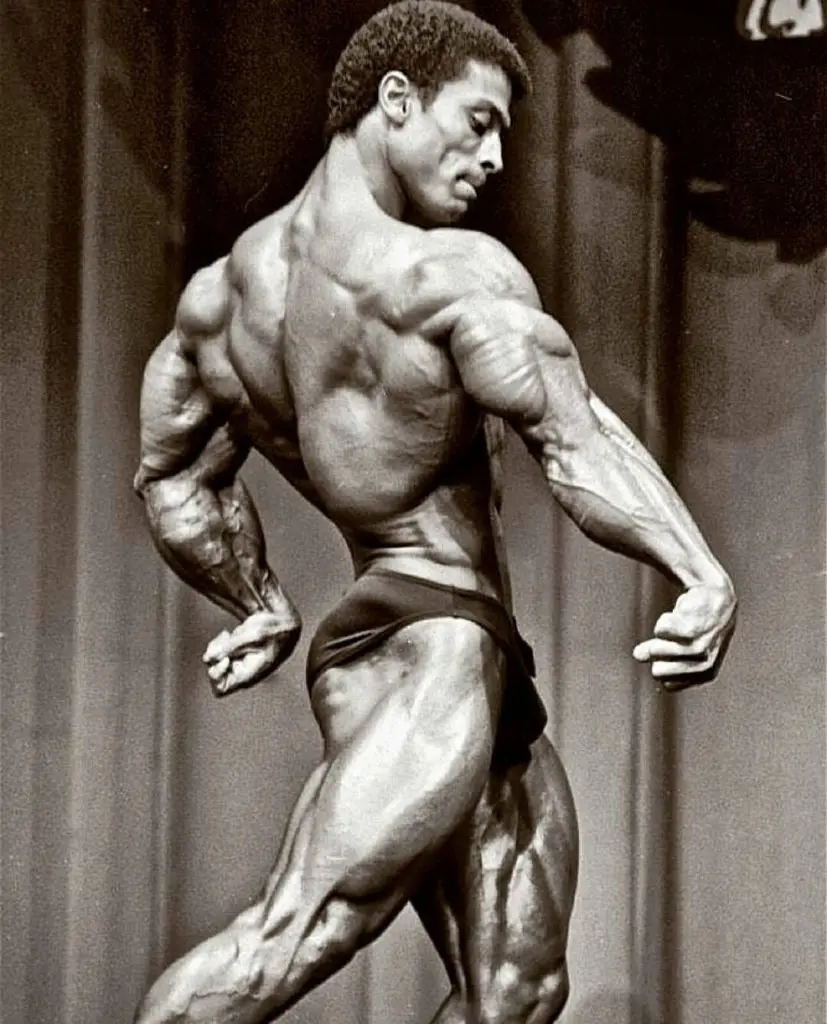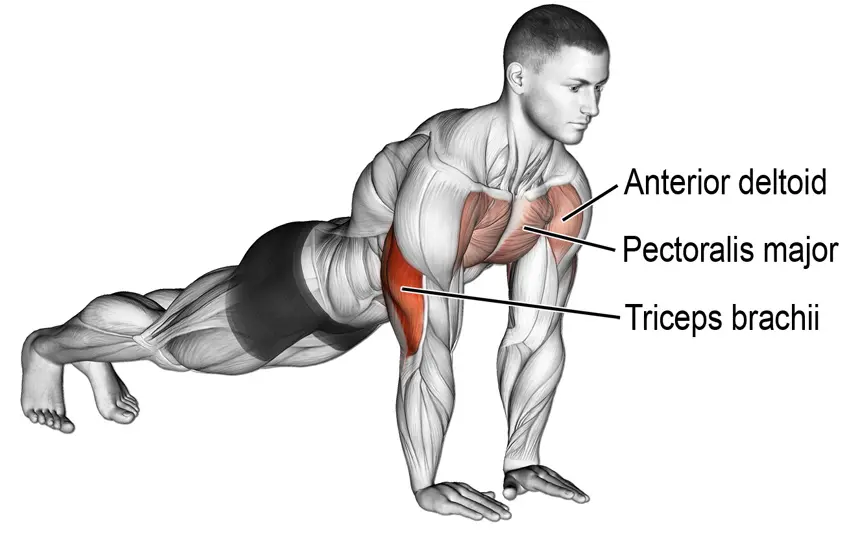When most people do bench presses, they do them with their hands at least shoulder-width apart, and usually wider than that. Why? Because that is arguably the best way to activate your chest muscles. After all, that’s why most lifters do bench presses – they want bigger pecs!
However, the bench press works more than your chest; it also involves your anterior deltoids or front shoulders, and also your triceps. If you want to lift as much weight as possible, you must position your hands so that these muscles can generate the most force. Again, that’s a wide grip.
A lot of exercisers rely on the bench press on chest day, but this exercise is more than a just a pec builder. Simply changing the position of your hands turns it into an excellent triceps builder (1). Your pecs and delts are still involved in close-grip bench presses, but your triceps play a much bigger role.
Learn how to do close grip bench presses properly, what mistakes you should avoid, the benefits, and a few variations to use that will liven up your triceps workouts.
How to Do The Close Grip Bench Press
If you are serious about getting results from this exercise, you need to be serious about doing it properly too. The correct form will minimize your risk of injury while ensuring that each rep you perform is as productive as possible.
Exercise Instructions
- Lie on the bench with your feet flat on the floor. Reach up and grab the bar with an overhand, slightly narrower than shoulder-width grip. Your arms should be vertical and parallel to one another. Have a spotter check this for you.
- Brace your abs, pull your shoulders down and back, and lift the bar off the supports.
- Without moving your feet, bend your arms, and lower the bar to your sternum. Pull your elbows into your sides and touch the bar down lightly. No bouncing!
- Drive the bar back up to arms’ length and repeat.
Step-by-Step Guide to Proper Form
Achieving the most from the close-grip bench press requires adhering to the correct form. This step-by-step guide will lead you through the right technique to avoid injuries and maximize benefits:
Level Up Your Fitness: Join our 💪 strong community in Fitness Volt Newsletter. Get daily inspiration, expert-backed workouts, nutrition tips, the latest in strength sports, and the support you need to reach your goals. Subscribe for free!
- Setup: Lie on a flat bench with your feet flat on the ground. Grasp the barbell with your hands shoulder-width apart or slightly narrower.
- Lift Off: Lift the barbell off the rack, positioning it straight over your chest with your arms fully extended.
- Lowering the Bar: Inhale as you slowly lower the bar towards your chest, ensuring your elbows are tucked in close to your body.
- Pressing Up: Push the bar back to the starting position while exhaling, making sure to engage your triceps during the movement.
- Repeat: Perform your desired number of reps, always maintaining the right form.
Adjust Your Weights and Reps to Match Goal
- For strength: 3-5 reps using 85%+ of your one-repetition maximum (1RM). Rest 3-5 minutes between sets.
- For hypertrophy (muscle growth): 6-12 reps using 67-85% of your 1RM. Rest 60-90 seconds between sets.
- For muscular endurance: 13-20+ reps using less than 67% of your 1RM. Rest 30-60 seconds between sets.
Muscles Worked by the Close-Grip Bench Press

The close-grip bench press is a compound exercise, meaning it recruits multiple muscle groups simultaneously. It’s a superb workout for achieving overall upper body strength and conditioning, primarily focusing on the following muscle groups:
Primary Muscles Worked
- Triceps Brachii: The close-grip bench press places primary emphasis on the triceps. This muscle group, located at the back of the upper arm, is responsible for elbow extension. The close grip shifts the work from your chest and shoulders directly onto the triceps, making it a powerful exercise for building tricep strength and size.
- Pectoralis Major: Although the close-grip bench press focuses primarily on the triceps, it also effectively engages the chest muscles, particularly the lower part of the pectoralis major.
Secondary Muscles Worked
- Anterior Deltoids: The front part of your shoulder, known as the anterior deltoid, plays a supporting role in this exercise. It aids in the pressing movement and helps stabilize the shoulder joint.
- Serratus Anterior: This muscle, located along your ribs, also works during the exercise, aiding in scapular movement and stability.
- Core Muscles: While not the primary focus, the core muscles including the rectus abdominis and obliques are engaged to maintain stability during the lift.
Remember, engaging the right muscles and focusing on the mind-muscle connection can significantly enhance your results from the close-grip bench press. Always ensure proper form and technique to effectively target these muscle groups.
Common Close Grip Bench Press Mistakes to Avoid
Like any exercise, you’ll get better results from the close grip bench press if you do it correctly. Improper form may allow you to lift more weight or do more reps, but it also increases your risk of injury, and may even make the exercise less effective. Make sure you get the most from this exercise by avoiding these common mistakes:
Hands too close together
some old-school bodybuilders used to do this exercise with their hands so close together that their fingers touch. While this does put more tension on your triceps, it’s also very hard on your wrists and elbows. The risk of injury outweighs any potential benefits.
Instead, make sure your hands are correctly spaced. To determine the right grip, drop down into the push-up position and place your hands directly under your shoulders. That’s the grip width you need on the bar. This position is not only safer, but it’s also stronger and will allow you to lift more weight (2).
Incorrect bar path
To get the best chest-building benefits from the bench press, a lot of lifters lower the bar to their upper chests. This provides a good stretch, which can help increase muscle growth. However, this is not the correct bar path for the close grip bench press.
To maximize triceps recruitment, make sure you lower the bar to your sternum. Lowering it toward your upper chest could lead to elbow and wrists pain.
Too much or too little elbow tuck
Using a narrow grip means you’ll need to keep your elbows close to your sides. But you should avoid tucking your elbows so tightly to your body that they rub against your sides. Also, make sure your elbows don’t flare outward either, as this will rob you of pressing power. Instead, focus on keeping your elbows directly below your hands. This will minimize the stress on your wrists and elbows.
Benefits of Close Grip Bench Press
Still not sold on the close grip bench press? Here are some of the benefits that this excellent exercise offers:
Bigger, stronger triceps
Most triceps exercises are isolation exercises. Skull crushers, pushdowns, and kickbacks, etc., all involve movement at just one joint, specifically the elbow. This severely limits the amount of weight you can lift, and therefore may restrict how much strength and muscle size you can build.
Close grip bench presses are a compound exercise, which means two or more joints are working together. This allows you to lift more weight and put more tension on the target muscles – the triceps.
Better bench press lockout
In the regular bench press, a lot of lifters struggle to lock their elbows at the end of a rep. Why? Because their triceps are weak. Their pecs are strong enough to get the bar moving up and off their chests, but, as they approach the end of the rep, their triceps can’t lock out the bar.
Close grip bench presses are one of the most movement-specific ways to strengthen your triceps. That’s why this exercise is so popular with powerlifters looking to boost their bench press performance. If you find yourself struggling to lock out your elbows during regular bench presses, the close grip bench press can help.
Level Up Your Fitness: Join our 💪 strong community in Fitness Volt Newsletter. Get daily inspiration, expert-backed workouts, nutrition tips, the latest in strength sports, and the support you need to reach your goals. Subscribe for free!
Less shoulder stress
The barbell bench press is undeniably good for building muscle and strength, but it can also be hard on your shoulders. Some lifters may find that switching to a narrower grip takes stress off the shoulder joint, allowing for pain-free pressing. If regular bench presses hurt your shoulders, give close grip bench presses a try.

Variations and Alternatives
If you’ve mastered the close grip bench press, or simply want to add some diversity to your triceps workouts, here are three variations and alternatives to try.
1- Close Grip Floor Press
No free benches at the gym? No problem! You can do close grip floor presses instead. Floor presses stop you from bouncing the bar off your chest, making them a cheat-proof exercise.
How to do it:
1– Set the hooks on a squat rack to about mid-thigh height. Place a bar on the hooks and then lie on the floor beneath it. Your eyes should be directly under the bar.
2– Reach up and grab the bar with your usual close grip bench press hand position. Pull your shoulders down and back, arch your lower back, and plant your feet firmly on the floor.
3– Unrack the bar, bend your arms and lower the weight down until your triceps lightly touch the floor. Push the bar back up and repeat.
2- Close Grip Dumbbell Bench Presses
Fix left to right strength imbalances and develop better coordination by working each arm independently.
How to do it:
1– Sit on the end of an exercise bench with a dumbbell in each hand. Rest the weights on your thighs. Lie back on the bench and use your legs to help boost the weights up to arms’ length. Position the dumbbells so that the ends are touching.
2– Bend your arms and, keeping the dumbbells close together, lower the weights down to your chest.
3– Push the dumbbells back up to arms’ length and repeat.
You can also perform this exercise using a neutral or palms facing inward grip.
3- Close-Grip Push-ups
This exercise is ideal for anyone who wants to work their triceps but doesn’t have access to a gym. You can do close grip push-ups anywhere and anytime, even at home or in a hotel room.
How to do it:
1– Kneel down and place your hands flat on the floor. They should be directly under your shoulders with your fingers pointing straight ahead.
2– Walk your feet back until your body is straight, and your weight is supported on your hands and toes only.
3– Without lifting or lowering your hips, and with your core braced, bend your arms and lower your chest down to within an inch of the floor. Keep your elbows close to your sides.
4– Press yourself back up and repeat.

Conclusion
Whether you want bigger, stronger triceps, or just want a break from regular bench presses, the close grip bench press is a worthy addition to your workouts. It does feel different to regular bench presses, but different is good. Studies have revealed that exercise variety is every bit as important for muscle growth and building strength as different weights, sets, and reps (3).
Do this exercise as part of your arm workout, or in place of regular bench press in your chest workout, especially if wide grip bench presses bother your shoulders.
References:
- Lockie, Robert & Moreno, Matthew. (2017). The Close-Grip Bench Press. Strength and Conditioning Journal. 39. 1. 10.1519/SSC.0000000000000307.
- Lockie, Robert & Moreno, Matthew. (2017). The Close-Grip Bench Press. Strength and Conditioning Journal. 39. 1. 10.1519/SSC.0000000000000307.
- Fonseca RM, Roschel H, Tricoli V, de Souza EO, Wilson JM, Laurentino GC, Aihara AY, de Souza Leão AR, Ugrinowitsch C. Changes in exercises are more effective than in loading schemes to improve muscle strength. J Strength Cond Res. 2014 Nov;28(11):3085-92. doi: 10.1519/JSC.0000000000000539. PMID: 24832974.
Interested in measuring your progress? Check out our strength standards for Bench Press, Push Ups, Floor Press, and more.








